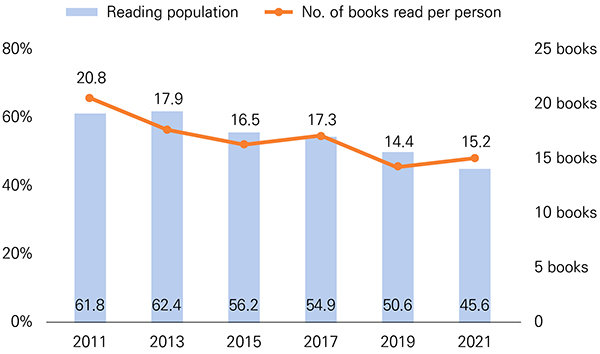|
Publishing Industry
The Vulnerability of Production Focused on Paper Books
2022.06.07
The advancement of science has brought development to media, including in variety. Also, as an IT powerhouse, Korea provides easier access to all sorts of content, enabling people across all age groups to enjoy visual fun and entertainment through visual content rather than books. The significant drop in public interest in paper books – the analog – can be easily seen in the statistics of the yearly decrease in the reading population.
Reading population and the number of books read per person (2011~2021)
* Source: Statistics Korea (11.17.2021), Social Survey Results in 2021
As you can start a book-publishing business with a relatively small financial basis, the entry barrier is not that high. If you are interested, you can take your first foot in the industry without much difficulty. However, it is at the same time the reality that most of the publishers, excluding some of the major ones, are small in size. The number of publishing companies registered by the Ministry of Culture, Sports, and Tourism was 67,203 as of late 2020, which annually increased by 6.55% over the past 10 years on average. Of course, not all these publishing companies publish new books, but the number of producers working with these many publishing firms is relatively small in comparison, which is even decreasing each year.
The cultural industry called publishing can be defined as an act of printing out certain works such as writings or pictures. In other words, publishing is a process of commercializing planned content using pictures and letters through a medium of “books.” As such, book production is turning intangible content into tangible books. There is no other country than Korea that puts so much effort into making books. From editing, including font size, space between letters and lines, left and right margins, sentences, and context, to devising a creative book design and making this processed content to be published as planned as possible would be the entire process of publishing a book.
Only accurate communication in each process would lead to efficient production of books.
Then, what factors support an effective and efficient production, and what are those that hinder it?
It is necessary to recruit professionals and complement aged facilities
There are more problems and weaknesses regarding paper book production than those mentioned in this article. This article touched on some of the representative cases that all publishing companies in Korea making paper books in the publishing and cultural industries are experiencing today. These weaknesses would be something that all the publishing companies across the world are struggling with. Individual efforts of each producer may not be enough as such a situation is in close ties with generational and social issues.
Written by Park Sang-Hyun (Manufacturing Manager at Gimm-Young Publishers, Inc., and a lecturer at the Hankyoreh Publishing Academy)
Park Sang-Hyun (Manufacturing Manager at Gimm-Young Publishers, Inc., and a lecturer at the Hankyoreh Publishing Academy) #Paper Book#Production#Price of books#COVID-19 |
||||||||||||||||||||||||||||||||||||||||||||||||||||||||||||||||||
Pre Megazine
-

New Tarot Made With Korean Colors and Patterns!
VOL.69
2024.04 -

Please Look After Mom by Shin Kyung-sook
VOL.69
2024.04 -

Paper Play – A Great Way for Emotional Development, Concentration, and Creativity!
VOL.68
2024.03 -

Submit Us Your Reviews of Korean Books!
VOL.68
2024.03 -

A Miraculous Workout Routine for a Healthier Body!
VOL.67
2024.02 -

The Hottest Place in Korea, Right Here, Right Now!
VOL.66
2024.01 -

Kim Jiyoung, Born 1982 by Cho Nam-Joo
VOL.66
2024.01 -

Concerning My Daughter by Kim Hye-jin
VOL.65
2023.12 -

Bake Delicious Bread that’s Just Right for Your Taste
VOL.65
2023.12 -

Craft Your Own Special Miniature Furniture
VOL.64
2023.11 -

Take Beautiful Palace Tours With a Book
VOL.63
2023.10 -

A Guide to Beautiful Korean Handwriting
VOL.62
2023.09 -

An Offbeat Trip to Jeju Island
VOL.61
2023.08 -

Prepare for Disasters with a Single Book
VOL.60
2023.07 -

The Hen Who Dreamed She Could Fly by Hwang Sun-mi
VOL.60
2023.07 -

Feel the Street Vibes with Watercolor Painting
VOL.59
2023.06 -

Bone Soup by Kim Young-tak
VOL.59
2023.06 -

Eat Healthier and Tastier – Korean Vegan Food
VOL.58
2023.05 -

Almond by Won-pyung Sohn
VOL.58
2023.05 -

Learn About and Have Greater Fun Drinking Korean Alcohol!
VOL.57
2023.04 -

Knitting YouTuber Daeri Kim’s “Easy Modern Daily Knit”
VOL.56
2023.03 -

A New Section for Readers’ Reviews!
VOL.55
2023.02








